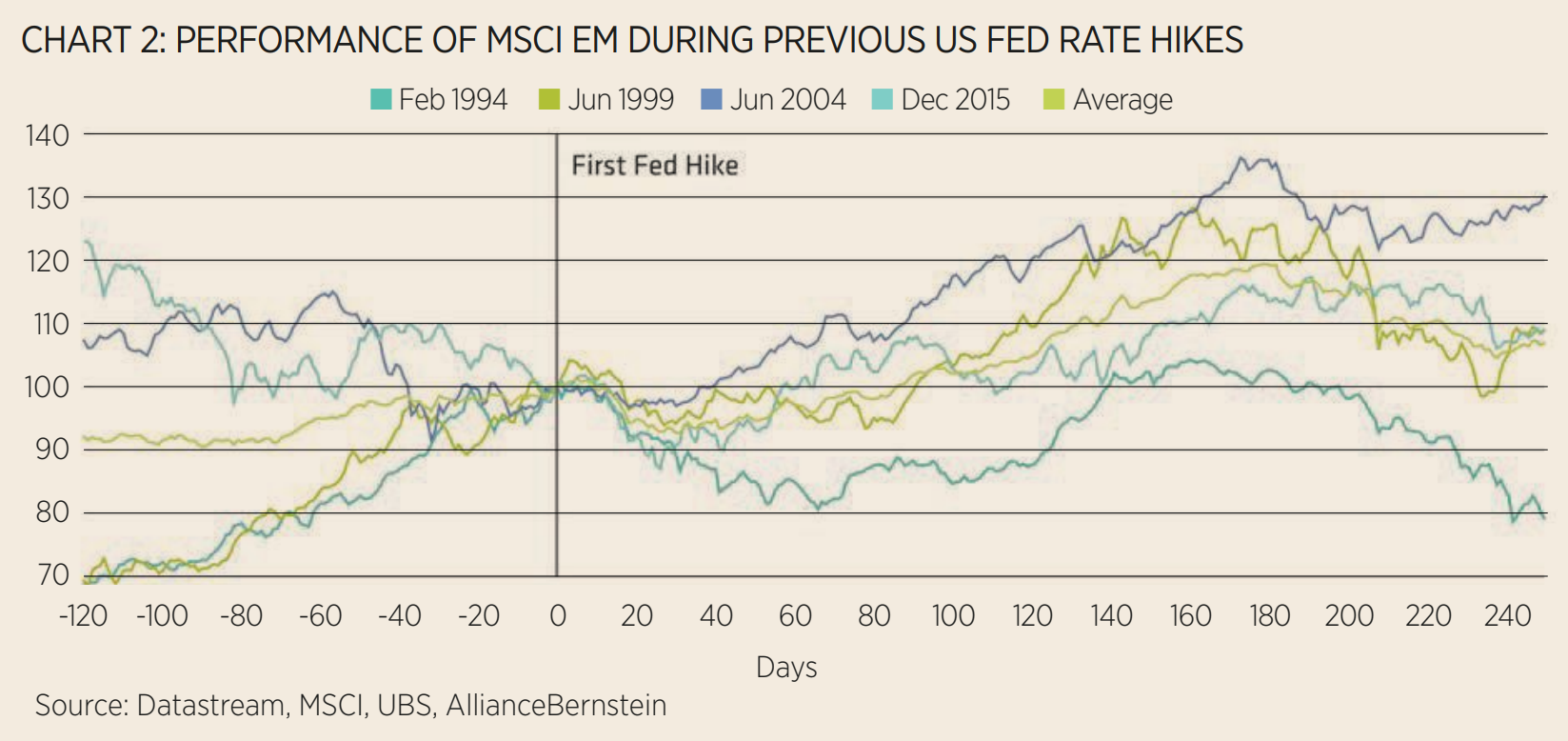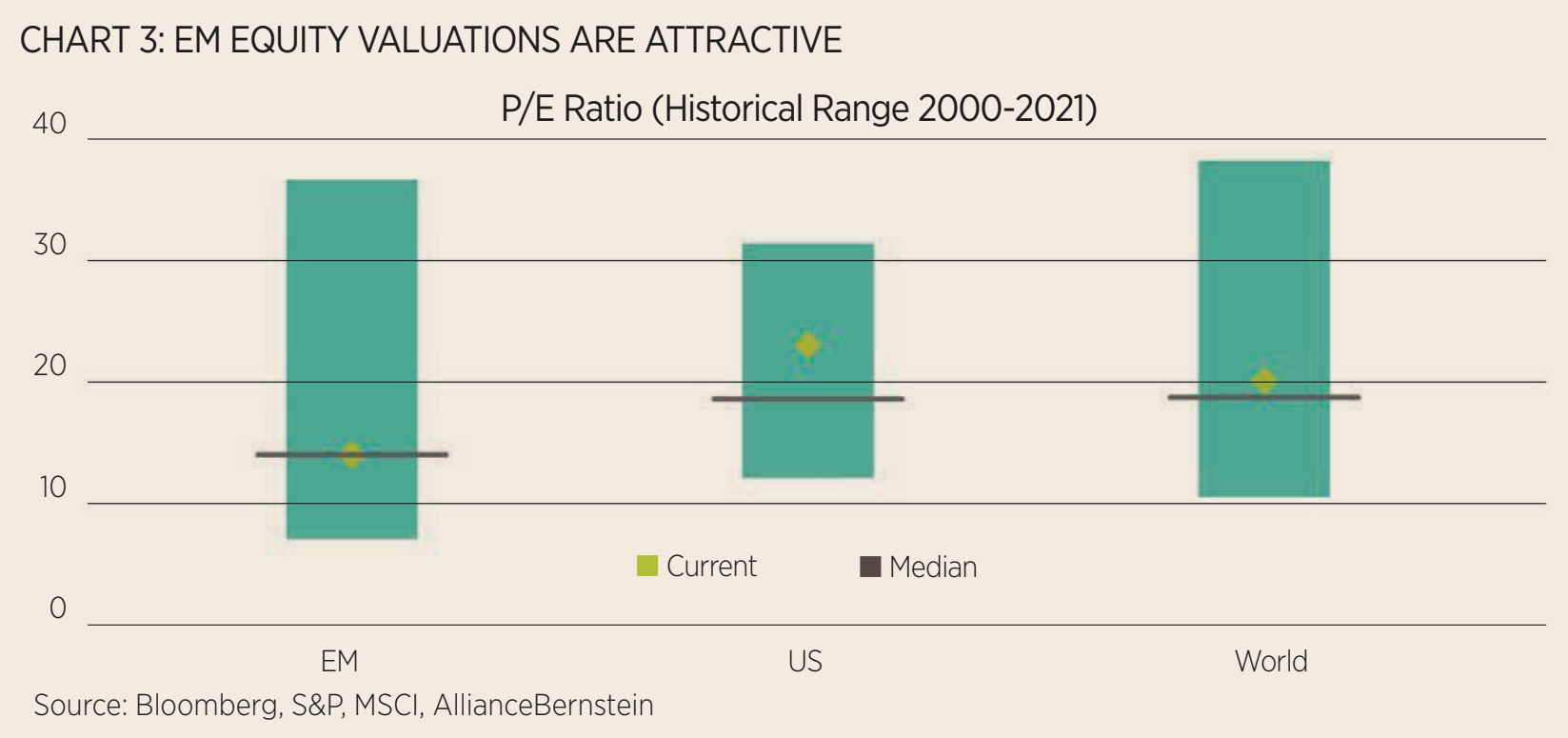After triple-digit underperformance since the Global Financial Crisis (GFC) in 2008 and negative returns since the start of the pandemic, investors need to decide whether emerging markets are now a coiled spring or just plain unreliable.
Between 2011 and 2021, the MSCI emerging market index underperformed US equities by 376% while in Q1 alone, the benchmark fell 7%, underperforming the MSCI World index by 1.8% in just 12 weeks.
Starting the year with COVID-19 still taking a toll on supply chains, western policymakers undergoing a hawkish pivot, Chinese real estate deflating, populists rising to power in Latin America and of course Russian aggression likely to have lasting impacts, some might think the outlook looks bleak. However, it may be too soon to rule out a roaring twenties for emerging markets.
The monetary angle
As with every economic grouping this year, questions around inflation, interest rates and currency strength are front and centre for emerging markets. In its 2022 outlook, Lazard Asset Management warned countries most dependent on external financing could face pressure as the Federal Reserve hikes interest rates leading to a stronger US dollar and thereby increasing the burden of borrowers’ US dollar-denominated debt.
Lazard added while rising inflation can be a relative advantage for some commodity-producing emerging markets, the inflation basket of others such as India and the Philippines are between a third and half exposed to food goods, meaning these countries will be pressured to continue hiking rates to keep prices in check if inflation rises further – with potentially stifling effects on economic activity.
Offering his view, Christopher Dembik, head of macro analysis at Saxo Bank, said his firm is concerned about emerging market debt, with public and private borrowing spiking “significantly” since the start of the pandemic, local and global interest rates rising and Sri Lanka’s recent default creating the possibility of contagion.
“This is not an isolated phenomenon,” Dembik argued. “A bunch of emerging market countries might have to deal with debt stress in the short and medium-term: Pakistan, Tunisia or Ghana, for instance. In all these three countries, the debt stock is above 80% of GDP and interest rates have risen sharply over the past year.”
Others, however, think emerging markets now find themselves on a strong footing versus their developed market counterparts. While Fed rates hikes will continue being the centre of attention this year, in February AllianceBernstein said most emerging market banks were not as extensively dovish as the US policymaker last year and in fact implemented a total of 84 rates hikes through 2021 – or 2,500 basis points cumulatively.
Vincent Deluard, director of macro research at Stone X, highlighted how many emerging markets are now either close to or in positive real rates territory, whereas the US, UK and eurozone are a long way off this pace, as at the end of March.
With real rates in or nearing positive territory, Deluard argued emerging markets can reduce inflationary pressures. This, he says, paves the way for improved economic activity via interest rate cuts, credit expansion, stronger domestic demand, foreign inflows and reduced cost of servicing foreign currency debt – which has been the cause of “repeated” balance of payment crises over the past decade.

Deluard continued, stating the outlook for emerging market equities could also be positive given their performance is positively correlated to their currencies.
Agreeing, AllianceBernstein said while Fed tightening will be a headwind for all markets, developing economies are not doomed to a downward spiral. In fact, the MSCI Emerging Market index booked positive returns in the months following three out of four of the Fed’s initial rate hikes over the past three decades.

Regarding emerging market debt levels, Deluard argued the “West’s deficits are emerging markets’ surpluses” as US, UK and eurozone dovishness during the pandemic means the account balances of typical US dollar debt addicts – India, Indonesia, South Africa, Argentina, Mexico and Brazil – are currently in their best shape in a decade, with all either in or approaching account surpluses.
Of course, if inflation and rates move too high across global economies, all financial assets could suffer and the relative outperformance of inflation-sensitive countries such as Brazil “may be immaterial to some clients”, said Peter Sleep, senior investment manager at 7IM.
Historically cheap valuations
One unavoidable topic of interest for emerging market investors over the past year has been sliding valuations as price points continue to dislocate from developed markets.
AllianceBernstein believes most of last year’s negative sentiment is priced in, with the MSCI Emerging Market index trading at a price to trailing earnings ratio of 13.4x at the end of January, a 35% discount versus developed market equities.
At the start of February, the asset manager said: “About 40% of emerging market stocks are currently 30% below their 52-week highs, compared to 11% and 16% for US and World equities, respectively.”

Certain sectors are trading at particularly pronounced discounts after a turbulent 2021. At the end of March the MSCI technology and real estate indices were at 40% and 69% discounts versus their developed market peers.
Speaking on China in particular, Sleep, said: “The Chinese market has already had a large sell-off and a part of the sell-off is COVID-19, so there may also be an opportunity in China now it is a lot cheaper. I would have thought that if China is unsynchronised with the West, then holding China could be a great diversifier, making it even more attractive.”
Lazard AM echoed this in its outlook, stating lower-valued shares with higher dividend yields and free cash flow yields in emerging market have become more sought after.
These factors along with lower valuation multiples could present investors with an “attractive entry point to the asset class”, it said.
Deluard argues dividend and earnings growth are the most sustainable sources of returns for emerging market investors and both are in positive territory.
The 2022 expected dividend yields of the MSCI Colombia, Turkey, and Brazil indices 2022 are 20%, 8.4%, and 7.7%, respectively, while the Brazil index is expected to earn $221 per share this year, up from $69 in the 12 months to the end of Q1. South Korea and India are also expected to grow their earnings by 84% and 95%, Deluard said.
Another area of interest has been emerging market debt, with Russia’s invasion of Ukraine causing the asset class to suffer “one of its worst drawdowns in recent history and underperform nearly all other fixed income markets”, Lazard AM said.
With around $21bn withdrawn from emerging market debt (EMD) in the six months to April 2022, the JP Morgan Emerging Market Bond index had an index-level spread of 465 basis points (bps) and a yield of more than 7%, a combination previously only seen during peak COVID-19 volatility and the GFC, since EMD gained investment-grade status in 2005. Lazard said it has a “high conviction” that EMD will deliver strong returns over the medium term.
The macro view
Panning out to a more economic and politics-based outlook for emerging market, Deluard suggested there will be three tailwinds for outperformance.
First, it will be difficult for western economies to shake off their large deficits. Fiscal consolidation and deficit-cutting after the GFC has been followed by a period of Modern Monetary Theory by central banks and more populist politics with promises of fiscal generosity.
Deluard said these measures began with Donald Trump’s tax cuts but have taken root with governments’ “whatever it takes” approach to spending and debt during the pandemic. With many pre-COVID-19 spending plans put on hold and economic inequalities deepening over the past couple of years, political parties in the West will have to keep fiscal policy loose to appease popular discontent, Deluard continued.
Meanwhile, he argued emerging markets will enjoy surpluses, reserve accumulation and currency gains. Next, he said Vladimir Putin’s invasions of Georgia, Crimea, and Ukraine, as well as the US withdrawal from Afghanistan, show the era of the ‘peace dividend’ is over.
In preparation for further conflict, Deluard said: “Weapons must be bought, strategic resources must be secured, and exporters of oil, copper, cobalt, potash, lithium, nickel, and rare earth must be courted. This strengthens the terms of the trade for emerging markets, where most of these resources are located.”
Finally, he suggested many emerging markets are in prime position for a ‘demographic dividend’. Brazil’s dependency ratio has fallen to 62% from 94% in 1991 while Indonesia and South Asia will follow suit in the next decade and so too, eventually, will sub-Saharan Africa, Deluard said.
“The most growth-friendly environment is halfway through the demographic transition when age pyramids have a fat belly: a large working-age population, and few kids and elders to support,” he continued. “The fall in dependency ratios will mechanically increase these countries’ savings rate and surpluses.”
Ringfencing emerging markets
Unfortunately, classifying emerging markets involves the same challenge as the rest of indexing – namely choosing where to draw lines on what does and does not constitute a relevant exposure, often arbitrarily.
In the case of emerging markets, this means grouping together increasingly disparate economies of varying sizes, cultures and crucially, stages of development. This creates problems such as China floating between claiming a third and half the weight of the entire emerging market index.
Also, while some economies are in relatively early stages of development, China now has the second-largest GDP in the world and faces a dependency crisis more severe than Japan’s as baby boomers of the 1970s retire in the 2030s and are supported by the “tiny” one-child policy generation, Deluard warned.
Paraphrasing Chairman Mao’s view of the world divided into the US and its allies, China and the rest, Deluard went on: “China’s rise was not that favourable for most emerging markets. Outside of an ultimately unsustainable boom for commodity exporters, competition from China’s cheap labour and undervalued currency slowed the convergence of non-Asian industrial emerging markets, such as Mexico, Egypt, and Turkey.
“These countries have the most to benefit from the new world order and the coming new golden decade for ‘the third world’.”
The key for investors is not viewing emerging market constituents as homogenous. While the top three performing markets in Q1 were Brazil, Peru and Colombia, the bottom three were Russia, Egypt and Hungary – with Russia now excluded from MSCI’s emerging market indices altogether.
The extent to which different markets enjoy a ‘roaring 20s’ could differ greatly across the 23 economies the International Monetary Fund (IMF) identifies as emerging markets – with their varying geographies, monetary policies, geopolitical risks, sector makeups and growth prospects.
This article first appeared in ETF Insider, ETF Stream's monthly ETF magazine for professional investors in Europe. To access the full issue, click here
Related articles





